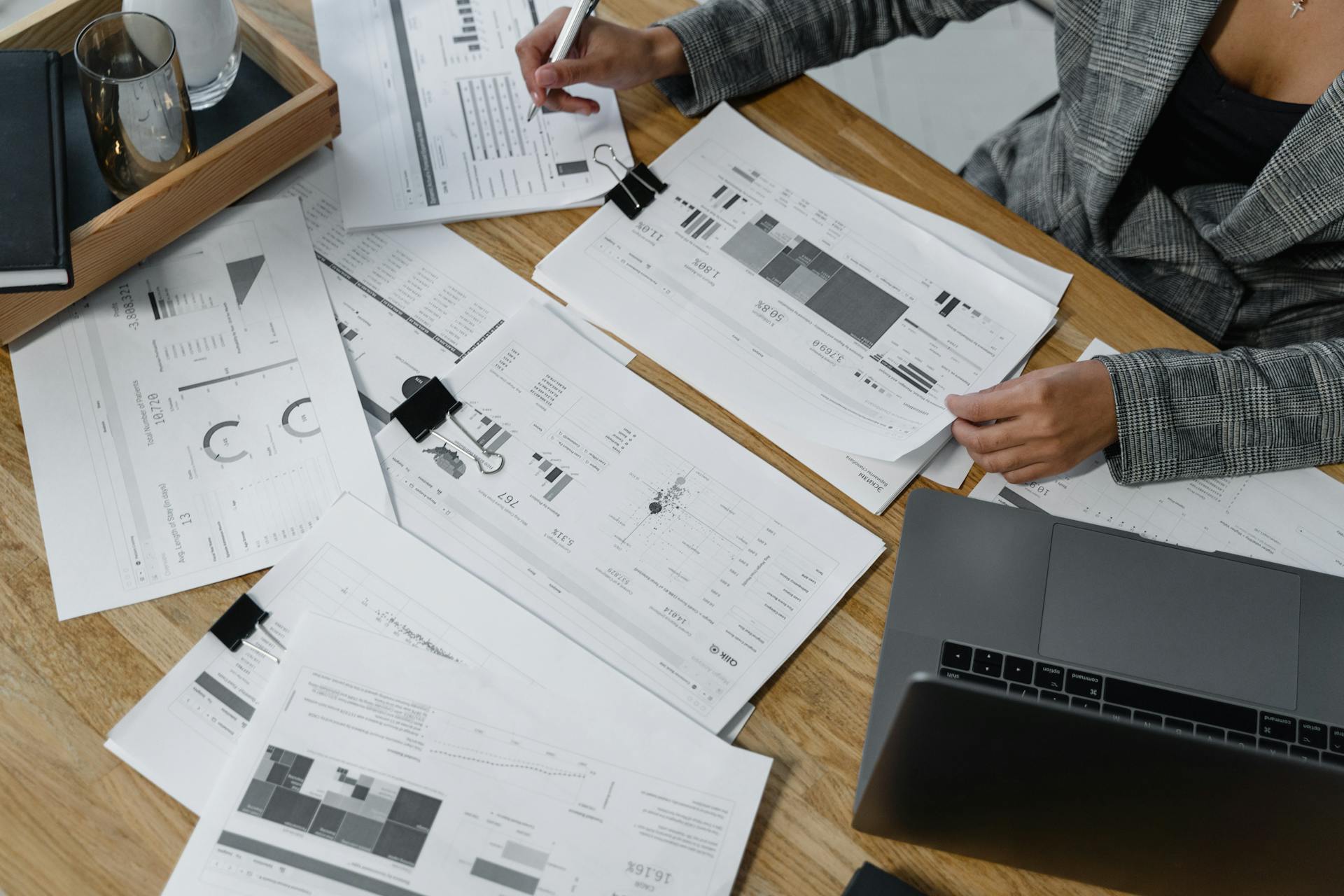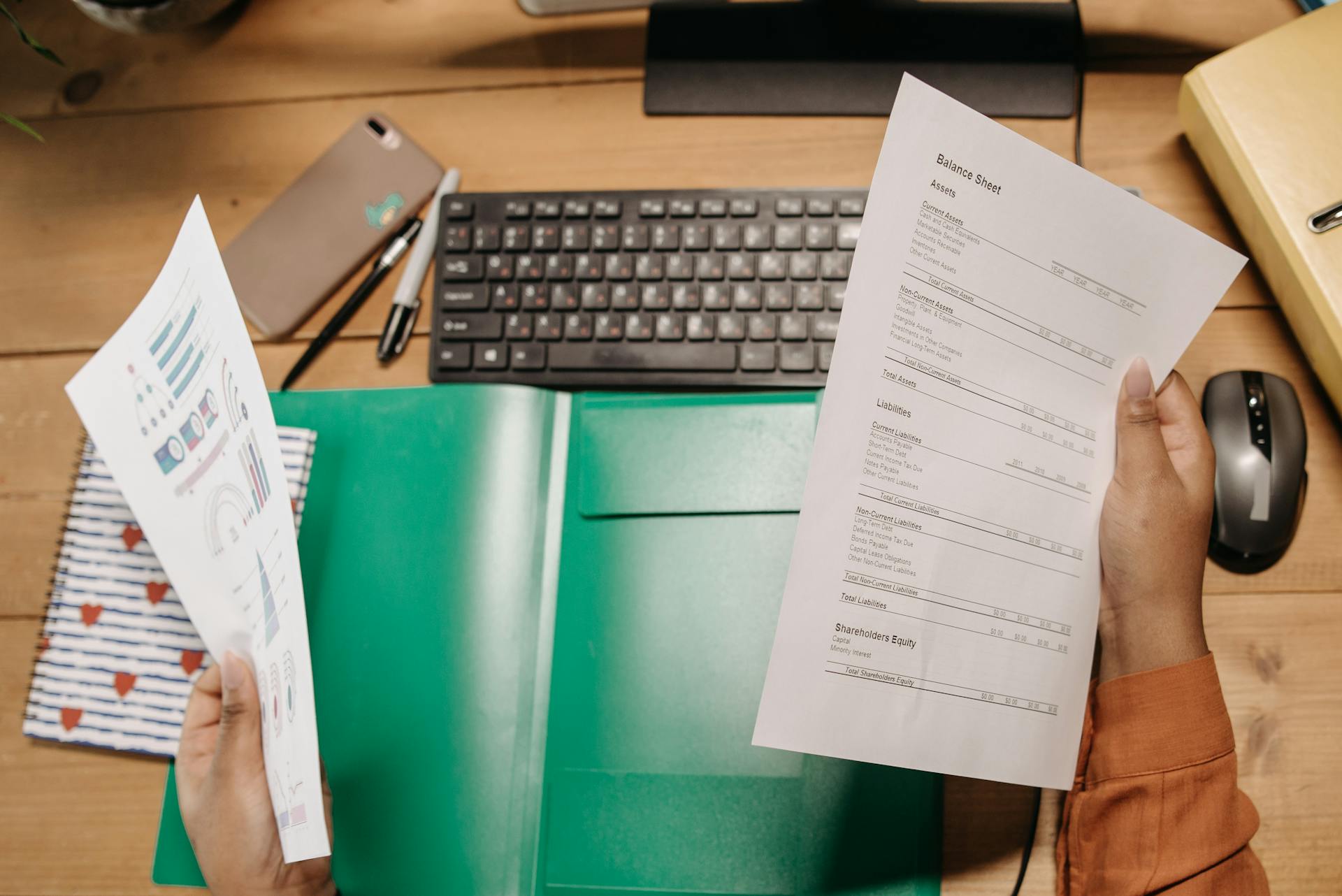
Accounting for liabilities is a crucial aspect of financial management, and it's essential to understand the different types of liabilities that businesses may encounter.
A current liability is a debt that a business expects to pay within a year or within its operating cycle, whichever is longer. This can include accounts payable, taxes owed, and accrued expenses.
Businesses often use the accounts payable method to record and manage their current liabilities. This involves recording a liability when goods or services are received, and then paying for them later.
Liabilities can significantly impact a business's financial health, and it's essential to accurately account for them to make informed decisions.
Explore further: Difference between Business and Personal Bank Account
What Is Liability?
Liability is a term in accounting that refers to any financial obligation a business has to pay at the end of an accounting period to another entity. This can include loans, accounts payable, mortgages, and more.
Liabilities are recorded on the right side of the balance sheet, which also includes loans, creditors, lenders, and suppliers. They can be settled by transferring economic benefits such as money, goods, or services.
Consider reading: Car Loans for College Students
Liabilities can be classified as short-term or long-term. Short-term liabilities are due within 12 months, while long-term liabilities become due within a duration of more than 12 months.
There are several types of liabilities, including any type of borrowing for improving a business or personal income payable later, a duty or responsibility forced by law on another entity, and a duty to other entities that involves settlement by transfer or use of assets.
Liabilities are a component of the accounting equation, where liabilities plus equity equals the assets appearing on an organization's balance sheet.
Here are some examples of liabilities:
- Loans
- Accounts payable
- Mortgages
- Deferred revenues
- Bonds
- Warranties
- Accrued expenses
Liability can also refer to the state of being responsible for something, such as tax liability or potential damages in a civil lawsuit. Many businesses take out liability insurance in case a customer or employee sues them for negligence.
Types of Liabilities
Liabilities are a crucial aspect of accounting, and understanding the different types can help you navigate financial statements with ease. There are three main categories of liabilities: current, non-current, and contingent.
Current liabilities are those that are due and need to be paid within an accounting period, usually a year or 12 months. Examples of current liabilities include interest payable, accounts payable, accrued expenses, and bank overdraft.
Non-current liabilities, also known as long-term liabilities, are financial obligations that are due in over a year's time. These liabilities help businesses acquire capital assets and finance long-term operations. Examples of non-current liabilities include deferred tax liabilities, bonds payable, capital leases, and debentures.
Contingent liabilities are a special type of liability that may occur depending on the outcome of future events. Examples of contingent liabilities include product warranties, lawsuits, penalties or fees, and unearned warranty revenue.
Here's a breakdown of the different types of liabilities:
In summary, understanding the different types of liabilities is essential for making informed financial decisions and navigating financial statements. By recognizing the characteristics of each type of liability, you can better manage your finances and make smart business decisions.
You might enjoy: Capital Budgeting Decisions Include
Classifying Liabilities

Liabilities can be classified as current or non-current, depending on their time horizon. Current liabilities are due within a year and are often paid using current assets.
A key factor in determining whether a liability is current or non-current is its due date. If a liability is due within 12 months or less, it's considered current. This is the case for accounts payable, commercial paper payable, and trade notes payable, which are all examples of current liabilities.
Current liabilities can be further broken down into short-term liabilities that are due within a year and operating costs such as salaries payable and interest payable. Non-current liabilities, on the other hand, are due in more than one year and include debt repayments and deferred payments.
Here's a summary of the key differences between current and non-current liabilities:
Understanding the characteristics of liabilities, such as being a present obligation, unavoidable, and resulting from a past event, can also help in classifying them.
Non-Current

Non-Current Liabilities are just as important as Current Liabilities in understanding a company's financial health. They are long-term obligations that are due in more than one year.
Non-Current Liabilities can include debt repayments and deferred payments, which can be a significant burden on a company's finances. Long-term debt is often the largest liability and is usually recorded as bonds payable.
Companies finance part of their ongoing long-term operations by issuing bonds, which are essentially loans from each party that purchases the bonds. This line item is in constant flux as bonds are issued, mature, or called back by the issuer.
Some examples of Non-Current Liabilities include rent, deferred taxes, payroll, and pension obligations. These liabilities can have a significant impact on a company's financial statements and should be carefully managed.
Here are some specific examples of Non-Current Liabilities:
- Warranty liability: This is the estimated time and money that may be spent repairing products under the agreement of a warranty.
- Contingent liability evaluation: This is a liability that may or may not occur depending on the outcome of an uncertain future event.
- Deferred credits: This is a broad category that can be recorded as current or non-current depending on the specifics of the transaction.
- Post-employment benefits: These are benefits that an employee or family member may receive upon their retirement.
- Unamortized investment tax credits (UITC): This represents the net between an asset's historical cost and the amount that's already been depreciated.
These are just a few examples of the many types of Non-Current Liabilities that companies may have. Understanding these liabilities is crucial in evaluating a company's financial health and making informed business decisions.
Essential Characteristics

Classifying liabilities can be a bit tricky, but understanding their essential characteristics can make it easier. A liability is a present obligation that will be settled in the future using cash, goods, or services.
For example, if you have a bank loan that needs to be repaid after two years, you have a present obligation to repay the loan, but the actual payment will be in two years' time. This is a clear case of a liability.
Liabilities are often unavoidable, arising from contractual and legal obligations. Paying taxes is a legal obligation, which is unavoidable. If you don't fulfill your obligations, the other person can sue or ask for damages.
To determine if a transaction is a liability, consider the following characteristics:
- It's a result of a past event. Past events give rise to a liability, such as transactions to purchase goods or services on credit.
- It's an unavoidable obligation. Liabilities often arise from contractual and legal obligations.
These characteristics can help you identify liabilities and accurately classify them in your financial records.
Calculating Liabilities
Liabilities are calculated by subtracting owner's equity from total assets.
The accounting equation, $5,000 Assets = $5,000 Liabilities + Equity, shows how liabilities and assets are equal to equity.
Explore further: Accounting Assets Liabilities Equity
Current (Near-Term)
Current liabilities are due within a year and are often paid using current assets. These liabilities can be paid using cash or short-term assets like accounts receivable or inventory.
Some examples of short-term liabilities include payroll expenses and accounts payable, which can include money owed to vendors, monthly utilities, and similar expenses.
Wages payable is a common short-term liability, representing the total amount of accrued income that employees have earned but haven't yet received.
Interest payable is another short-term liability, representing the interest on short-term credit purchases that must be paid.
Dividends payable is a short-term liability that represents the amount owed to shareholders after a dividend was declared for companies that have issued stock to investors and pay dividends.
Unearned revenues is a short-term liability that represents a company's liability to deliver goods and/or services at a future date after being paid in advance.
Here are some examples of current liabilities:
- Accounts payable
- Commercial paper payable
- Trade notes payable
- Short-term notes payable
- Salaries payable
- Wages payable
- Interest payable
- Income tax payable
- Current balance of long-term debt due in a year
- Callable long-term debt like bonds
The Formula
The Formula of Liabilities in Accounting is a simplified representation of how the financial side of a business functions. It's a crucial concept to grasp in order to understand the financial health of a company.

Liabilities are the amount that differs between an organization's total assets and its owner's equity. This means that liabilities are essentially the debts that a business owes to others.
The Formula of Liabilities is a straightforward calculation that helps businesses understand their financial obligations. It's a powerful tool that can be used to make informed decisions about investments, loans, and other financial matters.
In simple terms, the Formula of Liabilities is: Liabilities = Total Assets - Owner's Equity. This formula highlights the importance of managing liabilities in order to maintain a healthy financial balance.
Recommended read: Accounting Formula Assets Liabilities
Frequently Asked Questions
What is the journal entry for liabilities?
To record a liability, a journal entry is made crediting accrued liabilities and debiting the corresponding expense account. This entry is reversed when the payment is made, removing the accrued liability from the books.
Featured Images: pexels.com


